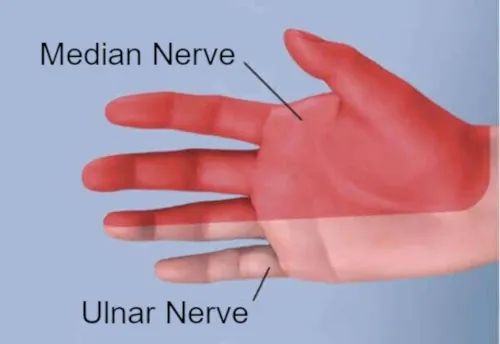How is Carpal Tunnel Diagnosed?
Table of Contents
- Overview
- Essential Parts of the Diagnosis
- History of symptoms
- Physical exam
- X-ray
- Ultrasound
- Electromyography (EMG)
- Nerve conduction study
- Risk Factors for Carpal Tunnel Syndrome
- Summary
- FAQs
- About
Overview
In order to diagnose carpal tunnel syndrome, your healthcare professional review your medical history, give you a physical exam, and ask a series of questions about your symptoms.
He or she may recommend having electrodiagnostic tests to check your nerves. These tests stimulate the nerves and muscles in your hand to check how well they work. Other tests like ultrasound and X-rays may also be warranted.
Essential Parts of a Carpal Tunnel Diagnosis
History of symptoms
The pattern of your symptoms is important in making a diagnosis of carpal tunnel syndrome. Most people have symptoms fall into one or more of these patterns:
- Symptoms usually occur while holding a newspaper, a phone, or
gripping a steering wheel.
- Symptoms also occur while sleeping.
- Symptoms might even
wake you from sound sleep with a feeling of having to shake out your hand.
- Some people notice that numbness or pain is worse when they wake up in the morning.
Symptoms of carpal tunnel syndrome are most pronounced in the palm of the
hand and the fingers. But the little finger is never involved. The most common initial carpal tunnel symptoms include:
Eventually,
shooting electric shocks, hand
weakness, and hand clumsiness may appear. These are considered more advanced symptoms of carpal tunnel syndrome.
A proper evaluation by your healthcare professional can rule out disorders which cause similar symptoms. The most common disorders which can "mimic" carpal tunnel symptoms are:
Physical exam
Your healthcare professional tests the feeling in your fingers, as well as the strength of the muscles in your hand. Three "provocative tests" (Durkan test, Phalen test, and Tinel test) are often used, which require pushing, tapping, and bending your wrist. In doing so, you can provoke carpal tunnel symptoms to temporarily appear or worsen.
X-ray
You may need an X-ray of your wrist to exclude other causes of wrist pain. These are usually due to arthritis or a fracture. Thus, X-rays are used to rule out other conditions. They are not helpful in making a diagnosis of carpal tunnel syndrome.
Ultrasound
An ultrasound of the wrist provides a picture of the nerves and tendons deep inside. This can help show whether the median nerve is being confined (or entrapped) and compressed.
Electromyography (EMG)
Electromyography measures the small electrical discharges produced in your muscles. During this test, a thin-needle electrode is inserted into specific muscles of your hand to evaluate the electrical activity when a muscle contracts and rests. This test can identify damage to the muscles controlled by the median nerve. It can also rule out other conditions.
Nerve conduction study
This is a variation of electromyography. It requires two electrodes taped to your skin. A small shock is passed through the median nerve to see if electrical impulses are slowed down in the wrist's carpal tunnel space. Slowing is a sign of nerve damage. This test can be used to diagnose carpal tunnel syndrome and rule out other conditions.
Risk Factors for Carpal Tunnel Syndrome
There are known risk factors for getting carpal tunnel syndrome. They can increase the probability of seeing symptoms many-fold. The major risk factors include:
Summary
A number of disorders share similar symptoms with carpal tunnel syndrome. Therefore, in order to properly treat carpal tunnel, an accurate diagnosis is important. The diagnosis begins with your healthcare professional asking specific questions during a physical exam. Then you may require more specific tests including X-rays, ultrasound, electromyography, and a nerve conduction study.
FAQs
The EMG and nerve conduction study may feel uncomfortable. That's because needles must be inserted into your hand or arm to pick up tiny electrical signals.
- Is any test better than another?
It's best to have as many tests as possible to confirm carpal tunnel syndrome. That's because any one test can give a set of false-positive or false-negative results.
- Which is the most accurate test?
No test is more accurate than another. However, the combination of physical testing with EMG and a nerve conduction study are considered the gold standard for a diagnosis.
About





